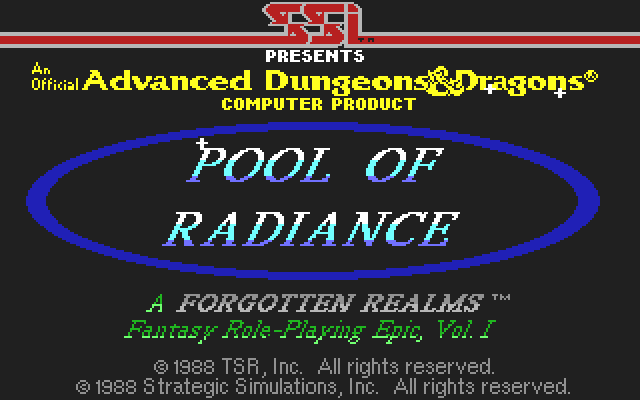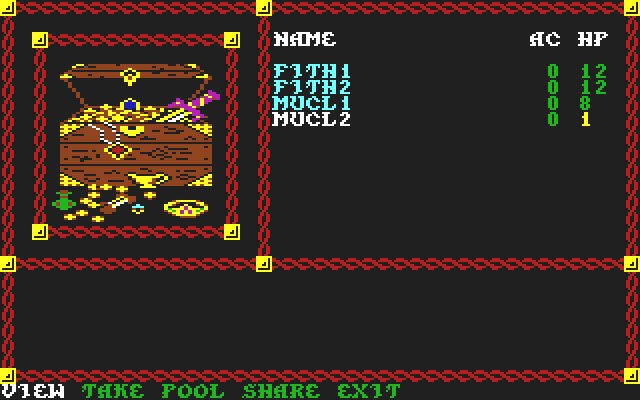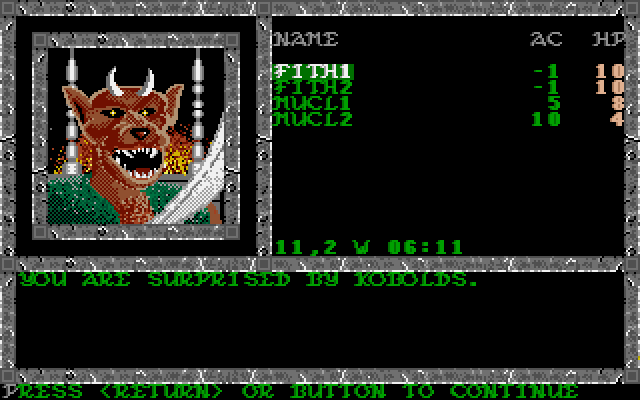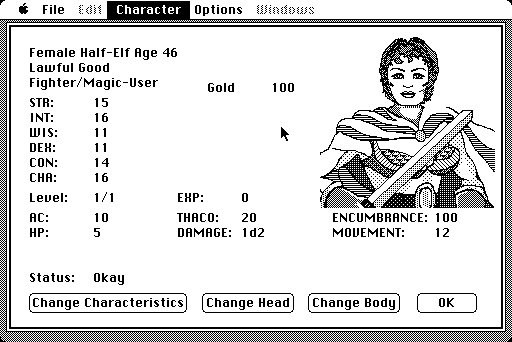Retro Replay Review
Gameplay
Pool of Radiance delivers a faithful adaptation of the Advanced Dungeons & Dragons combat and character‐development system, allowing players to assemble a party of six adventurers. You can either select a pre‐generated group or create your own, choosing from six races—human, elf, dwarf, gnome, halfling, and half‐elf—and four classes: fighter, cleric, wizard, and thief. Each character’s attributes and moral alignment can be fine‐tuned, giving a strong sense of ownership over your party’s chemistry and tactics.
(HEY YOU!! We hope you enjoy! We try not to run ads. So basically, this is a very expensive hobby running this site. Please consider joining us for updates, forums, and more. Network w/ us to make some cash or friends while retro gaming, and you can win some free retro games for posting. Okay, carry on 👍)
The exploration segments are presented in a pseudo‐3D, first‐person perspective. You’ll navigate winding streets, ruined buildings, and dangerous dungeons around the Moonsea’s northern shore. Random encounters trigger separate isometric combat screens where turn‐based battles unfold. Each action—whether swinging a sword, nocking an arrow, or casting a spell—consumes action points, requiring careful planning and resource management.
Character progression feels true to tabletop roots. Experience points earned through combat unlock extra attacks for fighters, backstab abilities for thieves, and expanded spell slots for clerics and wizards. Non‐human heroes can also multi‐class upon leveling, encouraging experimentation and long‐term strategic planning. The learning curve is steep, but the satisfaction of seeing a novice mage evolve into a versatile spellcaster is well worth the effort.
Graphics
For its time, Pool of Radiance’s visuals strike a good balance between atmosphere and clarity. The pseudo‐3D town exploration uses simple, blocky textures but effectively conveys a grim, monster‐ridden Phlan. Subtle ambient details—the flicker of torchlight on crumbling walls, the twisting alleyways—help immerse you in the Forgotten Realms setting.
Combat transitions to an isometric, grid‐based view where character sprites and enemy models appear more detailed. Animations are basic by modern standards—sword strikes flash, spells glow—but they’re smooth enough to keep engagements readable. Strategic positioning on the grid, combined with clear hit and damage indicators, ensures battles feel both tactical and rewarding.
The NES port, while more limited, deserves a nod for faithful reinterpretation on hardware with fewer resources. Textures are color‐reduced, character portraits are simplified, and dungeons are smaller, but the game’s core visual identity remains intact. If you’re seeking nostalgia or prefer console controls, this version still holds its own as a visual artifact of early RPG history.
Story
The plot kicks off on Phlan’s battered streets, where monsters have overrun most districts and turned flourishing trade routes into ruins. Only New Phlan stands safe, but its citizens dare not venture beyond the city walls. Authorities spread rumors of untold riches hidden in the infested zones to lure brave souls into cleaning up the mess.
Your party’s journey unfolds through journal entries, NPC interactions, and quest objectives that tie back to the overarching mission: reclaiming Phlan from the forces of darkness. From unraveling local politics to confronting fiendish masterminds in the depths, every twist feels grounded in the Forgotten Realms lore. The Adventure’s Journal helps track clues, side‐quests, and hidden treasures, giving context to each monster scourge you eradicate.
While dialogue is text‐heavy and sprite‐based, the writing captures the grit and heroism of classic D&D campaigns. Compelling side stories—like rescuing kidnapped townsfolk or stabilizing a crumbling temple—add emotional weight to the main quest. The narrative pacing can feel deliberate, but it reflects the tabletop tradition of careful exploration and meaningful role‐play decisions.
Overall Experience
Pool of Radiance stands as a landmark title in computer role‐playing games, faithfully translating the Advanced Dungeons & Dragons rule set into an interactive format. Its blend of first‐person exploration and isometric combat remains engaging, especially for players who enjoy methodical strategy choices and long‐term character growth.
The game’s difficulty curve and text‐driven interface may challenge newcomers, but veterans of turn‐based tactics and D&D lore will appreciate the depth and authenticity. Random encounters keep tension high as you map out dungeons, and the character‐building options ensure each playthrough can feel unique.
Modern players seeking streamlined visuals and faster pacing might find Pool of Radiance dated, but its historical significance and rich mechanics still offer a rewarding experience. For fans of classic RPGs or those curious about the origins of computer‐based Dungeons & Dragons, Pool of Radiance remains a must‐explore adventure on the road to reclaiming New Phlan’s glory.
 Retro Replay Retro Replay gaming reviews, news, emulation, geek stuff and more!
Retro Replay Retro Replay gaming reviews, news, emulation, geek stuff and more!









Reviews
There are no reviews yet.